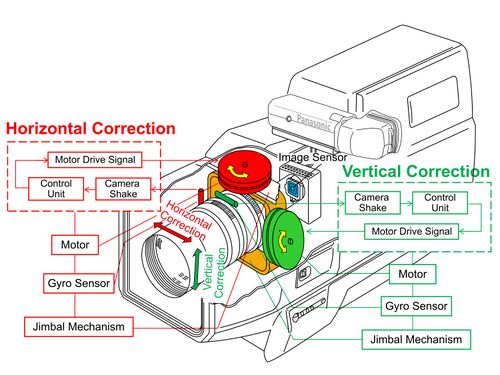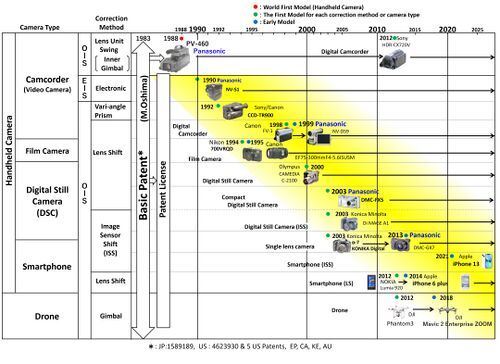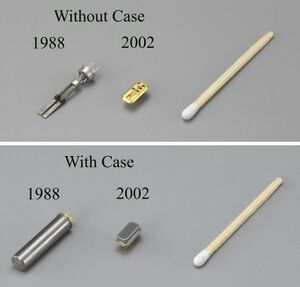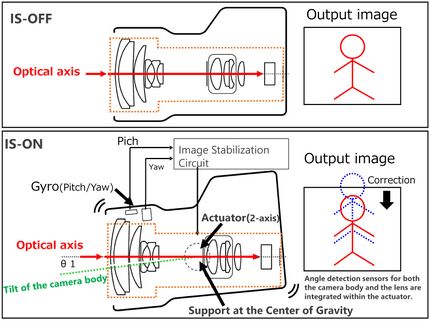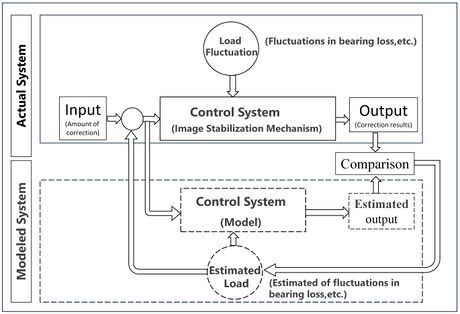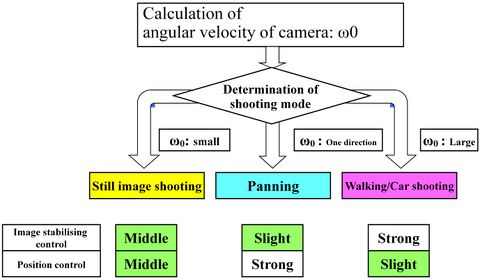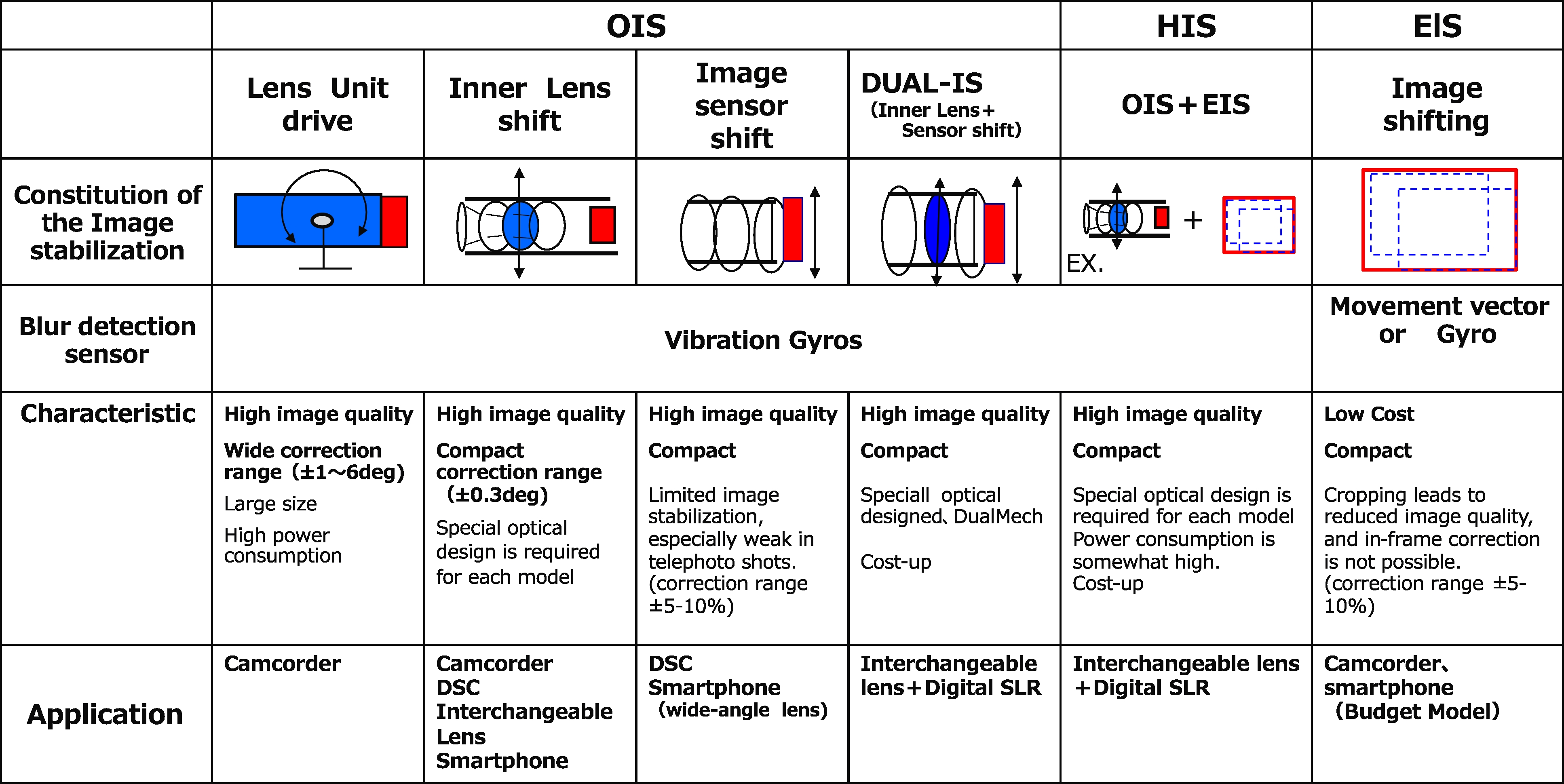Milestone-Proposal:Camcorder with image stabilization, 1988
To see comments, or add a comment to this discussion, click here.
Docket #:2025-15
This proposal has been submitted for review.
To the proposer’s knowledge, is this achievement subject to litigation? No
Is the achievement you are proposing more than 25 years old? Yes
Is the achievement you are proposing within IEEE’s designated fields as defined by IEEE Bylaw I-104.11, namely: Engineering, Computer Sciences and Information Technology, Physical Sciences, Biological and Medical Sciences, Mathematics, Technical Communications, Education, Management, and Law and Policy. Yes
Did the achievement provide a meaningful benefit for humanity? Yes
Was it of at least regional importance? Yes
Has an IEEE Organizational Unit agreed to pay for the milestone plaque(s)? Yes
Has the IEEE Section(s) in which the plaque(s) will be located agreed to arrange the dedication ceremony? Yes
Has the IEEE Section in which the milestone is located agreed to take responsibility for the plaque after it is dedicated? Yes
Has the owner of the site agreed to have it designated as an IEEE Milestone? Yes
Year or range of years in which the achievement occurred:
1988
Title of the proposed milestone:
First Camcorder with Image Stabilization, 1988
Plaque citation summarizing the achievement and its significance; if personal name(s) are included, such name(s) must follow the achievement itself in the citation wording: Text absolutely limited by plaque dimensions to 70 words; 60 is preferable for aesthetic reasons.
In 1988, the Panasonic PV-460 became the world's first camcorder equipped with image stabilization for enabling smooth and steady video capture. By pairing a miniaturized vibration gyroscope sensor with an optical axis correction mechanism, the blurriness caused by hand vibrations could be eliminated. Broad international licensing of this optical image stabilization scheme made it a standard feature in devices including film and digital cameras as well as smartphones.
200-250 word abstract describing the significance of the technical achievement being proposed, the person(s) involved, historical context, humanitarian and social impact, as well as any possible controversies the advocate might need to review.
In 1988, Panasonic released the PV-460, the world's first camcorder with a built-in image stabilization function. This groundbreaking development was based on a fundamental patent invented by Dr. Oshima et al. in 1983. This innovative technology achieved a breakthrough by seamlessly integrating a newly developed ultra-compact vibration gyro sensor with high stability and a precise correction mechanism into the camera and the its commercialization had an epoch-making impact, establishing image stabilization as a standard function in modern cameras.
Furthermore, the scope of the fundamental patent extended beyond optical or electrical correction to encompass a wide range of technologies, including lens unit swing methods and image sensor shift correction methods. These patents have been licensed to manufacturers worldwide, rapidly making this innovative technology a standard feature across industries such as film cameras, digital cameras, and smartphones. Today, cameras, including smartphones, equipped with image stabilization functions based on this invention are produced at an annual rate of 300 million units.
Before the commercialization of the PV-460, capturing stable footage often required a tripod or gimbal. Today, this innovative technology has revolutionized visual content creation, enabling smooth, professional-quality footage without the need for technical expertise or expensive equipment. As a result, it has had a profound and widespread impact on visual culture worldwide, and moreover, this technology is now widely applied to drones for capturing high-precision images during crucial infrastructure inspections, such as those of bridges, elevated highways, and high-voltage power lines, thereby making a significant contribution to society.
IEEE technical societies and technical councils within whose fields of interest the Milestone proposal resides.
IEEE Consumer Technology Society
In what IEEE section(s) does it reside?
IEEE Kansai Section
IEEE Organizational Unit(s) which have agreed to sponsor the Milestone:
IEEE Organizational Unit(s) paying for milestone plaque(s):
Unit: IEEE Kansai Section
Senior Officer Name: Takao Onoye
IEEE Organizational Unit(s) arranging the dedication ceremony:
Unit: IEEE Kansai Section
Senior Officer Name: Takao Onoye
IEEE section(s) monitoring the plaque(s):
IEEE Section: IEEE Kansai Section
IEEE Section Chair name: Takao Onoye
Milestone proposer(s):
Proposer name: Chiaki Ishikawa
Proposer email: Proposer's email masked to public
Proposer name: Mitsuaki Oshima
Proposer email: Proposer's email masked to public
Proposer name: Yoshinori Tanaka
Proposer email: Proposer's email masked to public
Proposer name: Takayuki Hayashi
Proposer email: Proposer's email masked to public
Proposer name: Hideki Aoyama
Proposer email: Proposer's email masked to public
Proposer name: Isao Shirakawa
Proposer email: Proposer's email masked to public
Please note: your email address and contact information will be masked on the website for privacy reasons. Only IEEE History Center Staff will be able to view the email address.
Street address(es) and GPS coordinates in decimal form of the intended milestone plaque site(s):
Panasonic Museum, 1006 Oaza-Kadoma, Kadoma, Osaka, 571-8501, JAPAN
N 34.738124, E 135.573697
Describe briefly the intended site(s) of the milestone plaque(s). The intended site(s) must have a direct connection with the achievement (e.g. where developed, invented, tested, demonstrated, installed, or operated, etc.). A museum where a device or example of the technology is displayed, or the university where the inventor studied, are not, in themselves, sufficient connection for a milestone plaque.
Please give the details of the mounting, i.e. on the outside of the building, in the ground floor entrance hall, on a plinth on the grounds, etc. If visitors to the plaque site will need to go through security, or make an appointment, please give the contact information visitors will need.
If your group is 10 people or more, please make a reservation.
- E-mail: panasonicmuseum.cs@kk.jp.panasonic.com
- URL: https://holdings.panasonic/global/corporate/about/history/panasonic-museum.html
Are the original buildings extant?
No. The research lab itself was demolished, so it no longer exists. Therefore, we plan to install the plaque at the Panasonic Museum, a corporate exhibition center close to the original site that is open to the public.
Details of the plaque mounting:
The plaque is to be displayed on the ground floor entrance hall of Panasonic Museum in Panasonic Holdings Corporation.
How is the site protected/secured, and in what ways is it accessible to the public?
Panasonic Museum provides a security control system with camaras and other security equipment. The plaque made accessible to the public with permission of Panasonic during normal business hours except, Sunday, and holidays.
Who is the present owner of the site(s)?
Mr. Yuki Kusumi, CEO of Panasonic Holdings Corporation.
What is the historical significance of the work (its technological, scientific, or social importance)? If personal names are included in citation, include detailed support at the end of this section preceded by "Justification for Inclusion of Name(s)". (see section 6 of Milestone Guidelines)
The historical significance of Panasonic's optical image stabilization technology in the "PV-460" for its application to the IEEE Milestone can be explained as follows:
Panasonic PV-460 Camcorder Overview
Released in 1988, the Panasonic PV-460 ( Fig.1 ) was the world’s first camcorder to feature an integrated image stabilization system [P1], [P2], [P4], [Pat1] to [Pat4]. This groundbreaking device addressed one of the most persistent challenges in handheld video shooting: camera shake. By incorporating a compact, lens-based stabilization mechanism directly into the camera body, the PV-460 allowed users to record smooth, stable footage without the need for external equipment such as tripods or gimbals-an unprecedented convenience at the time.
Image stabilization in cameras requires sensors that can detect rotation, since camera shake is a rotational movement. However, the gyroscopes, which were commercially available at the time, were much too large and expensive, making them unsuitable for handheld cameras. Under the circumstances, Panasonic's engineering team focused on vibration gyroscopes, which were small but unstable and not yet commercialized at the time, and developed a new structure to achieve an ultra-compact vibration gyroscope with stable performance. Furthermore, they developed a compact correction mechanism by correcting the optical axis in the opposite direction. Through these developments, they realized a compact and lightweight video camera equipped with a function to detect and correct camera shake in real time ( Fig. 2 ). This design enabled everyday users to capture high-quality video in various conditions, including motion-heavy or low-light environments.
The commercial and technological success of the PV-460 helped catalyze the widespread adoption of camcorders in households and also influenced the future development of video stabilization systems in digital cameras, professional video equipment, smartphones and drones. It stands as a key milestone in the history of imaging technology.
Historical Impact
Cameras that appeared at the end of the 19th century required a high level of skill to operate. Three failure factors, underexposure, out of focus, and camera shake, made it very difficult for amateurs to capture beautiful images.
As shown in Fig.3, three automation technologies were invented in the latter half of the 20th century to solve these problems. First, in 1956, Dr. Durst invented auto-exposure technology, and Agfa introduced the world's first auto-exposure camera, the Optima, in 1959. Next, Dr. Stauffer invented autofocus technology in 1973, and Konica Minolta introduced the world's first autofocus camera, the C35AF, in 1977. Finally, Dr. Oshima et al. invented image stabilization technology for handheld cameras in 1983, and Panasonic introduced the world's first image stabilization camera, the PV-460, in 1988.
Societal Impact
The release of the PV-460 brought a significant transformation to personal and home video recording, particularly for capturing travel experiences, events, and family memories. With its image stabilization feature, users could easily shoot stable footage, greatly reducing the technical barriers to filming. This enabled ordinary people to express themselves more creatively and freely through video, accelerating the adoption of home video cameras. Moreover, image stabilization technology has also found applications in specialized fields such as education and healthcare, contributing to the advancement of educational videos and telemedicine.
Technological Impact
Image stabilization was a revolutionary advancement in camcorder design. Prior to this, video cameras required users to consciously stabilize their shots to correct for shake, but the PV-460 featured a mechanical correction system that automatically stabilized footage, enabling anyone to easily capture stable video. As shown in Fig. 4, this technology later spread throughout the camera industry and was applied to digital cameras and smartphones, promoting improvements in video technology. Image stabilization dramatically improved the quality of footage in fast-moving scenes such as sports events or documentaries, opening new possibilities for video production.
Cultural and Industrial Impact
The spread of this technology had a significant impact on the video production industry. Traditional methods of shake correction (such as tripods or gimbals) often restricted the freedom of shooting, particularly in personal or small-scale productions. With the advent of the PV-460, high-quality footage could be achieved even with handheld cameras, significantly lowering the barriers to video production. As a result, video production became more accessible to a wider audience, allowing amateurs and low-budget productions to pursue professional-level quality. The evolution of image stabilization technology and its subsequent impact began with optical image stabilization (as introduced in the PV-460), and progressed to electronic image stabilization, and eventually to hybrid systems that combine both optical and electronic methods. Various approaches have since been developed, and today, such technologies are incorporated into nearly all modern video cameras, digital cameras, and smartphones. This advancement has not only improved video stability but also enhanced portability and versatility, fundamentally transforming the future of video production-from personal recordings to professional filmmaking. >>Fllowing the commercialization of the PV-460, various stabilization methods were developed. The PV-460 was later classified as an optical image stabilization system.
Expansion of the Market Size for Image Stabilization Technologies
Since the release of the PV460 camcorder with image stabilization in 1988, various types of stabilization technologies—such as optical and electronic image stabilization—have been developed and commercialized by manufacturers. In 1990, Panasonic introduced the NV-S1 camcorder with EIS. In September 1998, Canon commercialized an OIS using an inner lens shift mechanism, followed by Panasonic in March 1999. As a result, various types of image stabilization technologies were introduced to the market. As shown in Figure 5, by 1991, the domestic production value had reached approximately 6.7 billion dollars. Subsequently, the camcorder market formed a stable segment worth around 3.7 billion dollars, driven by improvements in image quality and video recording capabilities.
In the DSCs market, Olympus released the C-2100 Ultra Zoom—a high-zoom DSC equipped with OIS—in August 2000. In 2003, Panasonic launched compact models with OIS, such as the DMC-FX1 and FX5. These advancements led to significant growth in the DSC market from 2003 onward, reaching a scale of 19.4 billion dollars by 2008. The adoption rate of image stabilization also increased, and today, most camcorders and digital cameras come standard with this feature.
In smartphones, as image quality improved, Nokia introduced optical image stabilization in the Lumia 920 in 2012, followed by Apple with the iPhone 6 Plus in 2014. Since then, OIS has been increasingly adopted, particularly in high-end models, and is now expanding into mid-range devices. As shown in Figure 5, image stabilization technology has played a significant role in enhancing both image quality and functionality, contributing to the growth of the smartphone market, which is currently valued at approximately 320 billion dollars. Thus, the image stabilization technology that began with the PV460 has evolved and been passed down from camcorders to DSCs and smartphones. Furthermore, its application is expanding into professional camcorders, drones, and other devices.
Conclusion
The image stabilization technology in Panasonic's "PV-460" was not just a technological innovation but also brought significant changes to video production methods and the video culture in society. Its impact expanded the technical freedom in video production and revolutionized the way video recordings are made. For these reasons, this technology deserves to be considered for inclusion as an IEEE Milestone.
What obstacles (technical, political, geographic) needed to be overcome?
Obstacles
The optical image stabilization technology featured in the Panasonic "PV-460" released in 1988 represented an innovative advancement in consumer camcorders at the time. Achieving this technology required overcoming several significant technical challenges, and it involved creative solutions and technological advancements. The challenges and their solutions are explained as follows:
Development of a Compact and Cost-Effective Gyroscope Sensor for Camera Shake Detection
The biggest challenges in image stabilization has been detecting and correcting small camera movements, commonly referred to as camera shakes. These movements include horizontal, vertical, and rotational motions—specifically pitch, yaw, and roll. Rotational motion, in particular, becomes the dominant factor affecting image stability during high-magnification shooting. Therefore, we focused on detecting rotational motion and began developing an angular velocity sensor. At the time, sensors capable of detecting angular velocity were typically large and expensive, making them unsuitable for integration into consumer video cameras. This created a need for the development of a compact and low-cost sensor that could be embedded in such devices.
Miniaturization and weight reduction
Camcorders in the 1980s were much larger and heavier compared to modern models. Adding optical image stabilization required incorporating additional moving parts or mechanisms within the camera, which risked making it heavier and larger. As portability and ease of handheld shooting were important in consumer cameras, the challenge was to maintain miniaturization and lightweight design while implementing shake correction.
Achieving a High-Performance Real-Time Correction Control System and Enhanced Operability
Shake correction technology had to respond instantaneously to each instance of shake. Any delay in correction during video recording would result in unstable footage, which could be unpleasant for the user. The system needed to react quickly and accurately, especially when the frequency or intensity of the shake changed rapidly.
As shown in Fig. 8, the principle of image stabilization in the PV-460 using a vibration gyro, involves detecting camera shake (in the pitch and yaw directions) [P3]. Based on the detection signals from the Vibration gyros, the lens unit—which integrates both the lens and the image sensor—is driven by actuators in the direction opposite to the shake through a control circuit, thereby compensating for the camera shake. Fig. 9 shows the block diagram of the image stabilization control system. The control system consists of two control loops. One is an angular velocity feedback loop that compensates for camera shake. The other is a position control loop that aligns the central positions of the camera body and the lens unit. This configuration ensures that the image stabilization and shooting direction are aligned between the camera body and the lens unit, allowing the photographer to determine the shooting direction without any discomfort. Furthermore, during the development of the image stabilization system, two important issues were identified.
The first issue was that approximately 50 wires extended from the movable lens unit to the camera body, and disturbances such as the load from these wires degraded the control performance. To address this, Panasonic engineers focused on observer control (Fig. 10), which was a pioneering approach at the time, and successfully resolved the issue. The system detects the difference between the output of the actual system and that of a modeled system implemented using a microcomputer. Assuming that this output difference is caused by external disturbances, the observer estimates the disturbance load and applies control to counteract it, thereby preventing degradation in control performance.
The second issue was that, as image stabilization performance improved, the system would interpret the photographer’s intentional movement of the shooting direction as camera shake and compensate for it, making it difficult for the photographer to shoot in the intended direction. To resolve this, a shooting mode recognition algorithm was developed to identify the photographer’s shooting intent and state. As shown in Fig. 11, the system analyzes angular velocity signals—such as the magnitude of angular velocity and whether the movement is in a consistent direction—using the output from the angular velocity sensor. Based on this analysis, the system determines the photographer’s shooting intent and the state of camera shake, and optimizes both the image stabilization control gain and the position control gain between the camera body and the lens unit. This allows the shooting direction to be accurately aligned with the photographer’s intent, even during intentional movements such as panning, enabling natural and intuitive shooting without discomfort.
Cost and manufacturing complexity
The optical image stabilization mechanism was technically complex and could lead to high production costs. For a consumer camcorder, it was necessary to balance cost while maintaining sufficient performance. Additionally, the manufacturing process required precise assembly, adding to the complexity.
Consumer understanding and acceptance
At the time, optical image stabilization was a new technology, and consumers needed to understand its benefits and effectiveness. Without clear communication of the advantages, it would have been difficult to achieve sales success.
Conclusion
The optical image stabilization technology in the Panasonic PV-460 overcame several significant technical challenges to revolutionize the consumer camcorder market. By addressing issues like accuracy, miniaturization, real-time correction, manufacturing costs, and consumer education, this technology made video production more accessible and easier for a wider audience.
What features set this work apart from similar achievements?
Comparison with Other Methods
The PV-460, released by Panasonic in 1988, was the world’s first VHS camcorder equipped with an optical image stabilization (OIS) system. This innovation marked a significant milestone in the history of imaging technology. Since the debut of the PV-460, image stabilization technology has evolved significantly, leading to the development of various systems such as electronic image stabilization (EIS) and hybrid image stabilization (HIS). Each system has its own strengths and weaknesses, and comparing them highlights the importance of the first practical implementation of optical stabilization. (See Table 1)
Optical image stabilization(OIS)
OIS compensates for camera shake by physically moving optical components—such as the lens, image sensor, or a combined unit—based on the amount of shake detected by a gyro sensor. When shake occurs, the movable parts respond accordingly to stabilize the captured image. With advancements in technologies like aspherical lenses and semiconductors, multiple OIS methods have been developed:
(1) Lens Unit Drive Method (Swing Type)
Release Date: 1988 — Panasonic PV-460 (Camcorder) This method involves integrated control of both the lens unit and image sensor.
- Advantages:
Enables high image quality without degradation and a wide stabilization range (±1.4 screen widths or ±6 degrees at telephoto). It allows stable shooting even while walking or filming from a moving vehicle.
- Disadvantages:
Larger size and higher cost.
(2) Lens Shift Method
Release Date: 1998 — CANON FV-1 (Camcorder) By the late 1990s, optical designs using aspherical lenses allowed selective movement of certain lens elements for stabilization.
- Advantages:
Achieves high image quality and compact stabilization through dedicated optical design.
- Disadvantages:
Limited stabilization range (about ±0.3 degrees), suitable mainly for stationary shooting. Lens aberrations may affect image quality, and each lens requires custom design.
(3) Image Sensor Shift Method
Release Date: 2003 — Minolta DiMAGE A1 (Digital Still Camera) This system stabilizes images by driving the image sensor built into the camera body. It was originally developed for interchangeable-lens cameras, allowing image stabilization even when the lens itself lacked a stabilization mechanism. In modern DSLR and mirrorless cameras, rotational shake is also corrected by rotating the image sensor. This method has also seen increasing adoption in wide-angle cameras on smartphones.
- Advantages:
In digital SLRs and mirrorless cameras, stabilization is built into the camera body, allowing effective shake reduction even with lenses lacking stabilization.
- Disadvantages:
The stabilization range is limited to the active pixel area of the image sensor, typically set to about ±5–10% to maintain image quality.
(4) Dual-IS
Release Date: 2015 — Panasonic LUMIX G8 (Mirrorless Camera) This hybrid system combines the lens shift method and the image sensor shift method to enhance image quality, expand stabilization range, and improve performance.
- Advantages:
Achieves high image quality and extended stabilization range. Residual shake corrected by lens shift is further refined by sensor shift, including rotational shake, resulting in highly precise stabilization.
- Disadvantages:
Increased system complexity and cost due to the integration of two stabilization methods.
Electronic Image Stabilization (EIS)
EIS (Electronic Image Stabilization) detects camera shake using internal sensors-typically a Vibration gyros and compensates for it by trimming the captured image based on the Vibration gyro's signals through software processing. In some cases, instead of using Vibration gyros, stabilization is achieved by detecting motion vectors (amount of shake) directly from the captured images.
Released:
- Panasonic NV-S1, 1990
Advantages
- Compact and Cost-Effective Implementation
EIS does not require any mechanical moving parts for stabilization, enabling the miniaturization, weight reduction, and cost efficiency of cameras. This makes it especially beneficial for portable devices where compactness is crucial, such as budget smartphones and action cameras.
- Performance Enhancement via Software
EIS offers the flexibility to improve performance through software updates.
Disadvantages
- Image degradation
EIS leads to a reduction in resolution because it crops a portion of the effective pixels captured by the image sensor. Since image stabilization cannot be applied during the sensor’s exposure time, any motion blur must be corrected by trimming the blurred image. As a result, image quality degradation becomes more pronounced in scenes involving fast motion, those requiring high resolution, or zoomed-in shots.
- Limited correction effectiveness
EIS typically reserves about 5% to 10% of the image sensor area for stabilization, which leads to a drawback: as the zoom level increases, when stabilization becomes more critical, the effective correction area becomes narrower.
Hybrid Image Stabilization (HIS)
Hybrid image stabilization combines optical and electronic stabilization methods. It enhances overall correction performance by electronically compensating for subtle movements that optical stabilization alone cannot fully address (limited to video recording). Additionally, in smartphones, systems have been developed that combine optical stabilization with electronic correction using composite burst shooting.
Released:
- Panasonic HC-V700M (Camcorder), 2012
- Panasonic DMC-TZ40 (DSC), 2013
- Samsung Galaxy S6 (Smartphone: with composite burst shooting), 2015
Advantages
- Utilizes the benefits of both methods
HIS (Hybrid Image Stabilization) enhances stabilization performance by using OIS to correct primary camera shake and EIS to compensate for residual motion. Compared to using EIS alone, it requires less cropping, which helps preserve image quality.
- wide-range correction
It is possible to expand the stabilization range through the synergistic effect of both optical and electronic stabilization. However, since electronic stabilization involves image cropping, it may result in a narrower field of view.
Disadvantages
- Increased System Complexity and Cost
The inclusion of both OIS hardware and EIS processing leads to higher system complexity and increased costs.
- Increased battery consumption
Power consumption increases because both OIS control and EIS image processing are performed. This may affect the camera's battery life, especially during long shooting sessions.
Significance of the First Practical Application of Optical Image Stabilization.
The significance of Panasonic’s 1988 introduction of optical image stabilization lies in several key points:
- Preserving Image Quality
Optical image stabilization does not rely on digital processing, allowing for shake correction without compromising image quality. It made a significant contribution to improving video quality in consumer camcorders, especially during zoom or low-light filming. It provided ease and stability that previous stabilization methods (such as tripods or manual gimbals) could not achieve.
- Technological Breakthrough
Optical image stabilization was technically challenging, and its realization in a consumer product was groundbreaking. This innovation prompted other manufacturers to focus on the development of shake correction technologies, accelerating technological advances. Furthermore, the development technologies such as mode recognition algorithms have been carried over to digital cameras, contributing to improved performance. It also paved the way for future technologies like hybrid image stabilization.
- Impact on Consumers
The "PV-460" equipped with optical image stabilization provided consumers with an easy-to-use camcorder. It had a significant impact on the spread of camcorders, especially for capturing family memories or travel footage, by offering stable video footage with ease.
Conclusion
Optical image stabilization was a groundbreaking technological innovation for consumer camcorders, solving the problem of camera shake and significantly improving video quality. Compared to other stabilization methods like EIS or HIS, its ability to preserve image quality and provide precise shake correction was especially significant during the early 1990s. The practical implementation of this technology made video recording more accessible and laid the foundation for future technological advancements in the field of video production.
Why was the achievement successful and impactful?
The optical image stabilization technology in the Panasonic PV-460 was a highly significant and groundbreaking achievement in the camcorder industry. Below, I analyze why this achievement was successful and impactful.
First and foremost, the success was rooted in a technological breakthrough. Camera shake had long been a major obstacle in video recording, especially in dynamic scenes or handheld shooting. Prior to this innovation, users had to manually stabilize their cameras using tools such as tripods or gimbals. The breakthrough came with the development of a compact and low-cost gyroscope sensor. By using this sensor to accurately detect camera shake and physically compensate for it by moving lens components inside the camera, a revolutionary stabilization technology was realized. This allowed users to effortlessly capture stable footage without the need for manual correction. This was the first key factor behind the success of the PV-460, offering significant convenience to camera users.
Next, this technology had a significant social impact. The PV-460, released in 1988, made home video cameras much more accessible, greatly expanding the possibilities for video use in travel, family events, and even education and healthcare. The addition of shake correction meant that average consumers could easily record stable footage, which played an important role in the widespread adoption of home camcorders. This technological innovation also made video production more accessible to a larger audience and encouraged people to record more of their personal moments and memories.
Furthermore, The greatest strength of optical image stabilization was its ability to correct shake without degrading image quality. This was especially evident in zoom and low-light conditions, where the technology prevented digital noise and image degradation. This allowed users to achieve high-quality footage that was previously difficult to capture and made it possible for amateur users to create professional-quality video content. This was a major contributing factor to the success of optical image stabilization.
Finally, the impact on the industry cannot be overlooked. The introduction of optical image stabilization led other camera manufacturers to focus on developing shake correction technologies, which contributed to the later emergence of electronic and hybrid image stabilization systems. The evolution of this technology helped improve video quality across camcorders, digital cameras, and even smartphones. It lowered the barrier to video production and opened the field of video creation to a broader audience.
Supporting texts and citations to establish the dates, location, and importance of the achievement: Minimum of five (5), but as many as needed to support the milestone, such as patents, contemporary newspaper articles, journal articles, or chapters in scholarly books. 'Scholarly' is defined as peer-reviewed, with references, and published. You must supply the texts or excerpts themselves, not just the references. At least one of the references must be from a scholarly book or journal article. All supporting materials must be in English, or accompanied by an English translation.
Bibliography
Paper
[P1] M. Oshima, T. Hayashi. et al. "VHS camcorder with electronic image stabilizer" , IEEE Transactions on Consumer Electronics. Vol. 35, 4, November 1989 p.749-758Media:VHS camcorder with electronic image stabilizer.pdf
[P2] M. Oshima, "Technology to prevent image shake in consumer video cameras", Kogaku, Vol. 18, 11, p616-617. 1989 [JP]Media:Technology prevent image shake.pdf [EN]Media:Translated EN-Technology to prevent image shake.pdf
[P3] T. Inaji et al., "Image stabilizing technology for video camera", ITEJ Technical Report, Vol. 11, 28, pp.19-24, 1987 [JP]Media:Image stabilizing technology.pdf [EN]Media:Translated EN-Image stabilizing technology for video camera.pdf
[P4] M. Oshima, T. Hayashi, et al, "History of World's First Commercialization of Image Stabilizers for Handheld Cameras," 2023 8th IEEE History of Electrotechnology Conference (HISTELCON), Florence, Italy, 2023, pp. 56-58 Media:IEEE2023.pdf
Patent
[Pat1] Mitsuaki Oshima, Masataka Izaki, Jirou Kajino, Yoshiaki Igarashi, and Hiroshi Mitani, “撮影装置”, December 29, 1983. [JP] Media:JPPat.1589189_1983Oshima.pdf, [EN] Media:TranslatedEN JPPat.1589189 1983.pdf
[Pat2] Mitsuaki Oshima, Masataka Izaki, Jirou Kajino, Yoshiaki Igarashi, and Hiroshi Mitani, “Camera Apparatus”, December 31, 1984. Media:USPat.4623930 1984Oshima.pdf
[Pat3] Mitsuaki Oshima, Masataka Izaki, Jirou Kajino, Yoshiaki Igarashi, and Hiroshi Mitani, “Camera Apparatus with Fluctuations Suppressing Means”, April 12, 1990. Media:USPat.5020890 1990Oshima.pdf
[Pat4] Mitsuaki Oshima, Masataka Izaki, Jirou Kajino, Yoshiaki Igarashi, and Hiroshi Mitani, “Camera Apparatus”, August 30, 1991. Media:USPat.5294991 1991Oshima.pdf
[Pat5] Suzushi Kimura and Hiroshi Yamaguchi, “Angular Velocity Sensor”, March 21, 1985. Media:USPat.4671112 1985Kimura.pdf
News article
[N1] Lancelet Braithwaite; “Steady Cam”, Video Magazine, June, 1988.Media:N1 SteadyCam 198806En.pdf
[N2] Cliff Roth; “10 Top Camcorders,” Video, August 1988. Media:N2 10TopCamcorders 198806.pdf
[N3] "Finally, a camera with anti-shake function has arrived" Video capa 1988. P.52-53 [JP]Media:N3 VideoCAPA 198808.pdf, [EN]Media:N3 VideoCAPA 198808EN.pdf
[N4] "Camcorder with Auto Image Stabilizer (AIS)", Nikkan Kogyo Shimbun, page 8.,18 November 1988. [JP] Media:1988, Nikkan Kogyo Shimbun JP.pdf, [EN] Media:1988, Nikkan Kogyo Shimbun EN(AIS).pdf
[N5] "Award ceremony for the top 10 new products of 1988", Nikkan Kogyo Shimbun Nov. 18 1988. [JP] Media:N5 TOP10awards 19890126.pdf [EN] Media:Tranlated EN-TOP10awards 1989.pdf
[N6] Ted Katauskas, “The 1989 R&D 100 Award Winners", R&D Magazine, 1989. Media:N6 1989R&D100 1989.pdf
Award
[A1] "Development of a VHS movie with an anti-shake mechanism", The Institute of Television Engineers Technical Progress Award Development Award 1989.[JP]Media:ITEJ-Vol.43,No.8.pdf, [EN]Media:Translated EN-ITEJ-Vol43.No8.pdf
[A2] "Image stabilization technology", M. Oshima, J. Kajino, et. al., Imperial Invention Prize 2003.[JP]2003恩賜発明賞, [EN]Media:Imperial_Invention_Award.pdf
Supporting materials (supported formats: GIF, JPEG, PNG, PDF, DOC): All supporting materials must be in English, or if not in English, accompanied by an English translation. You must supply the texts or excerpts themselves, not just the references. For documents that are copyright-encumbered, or which you do not have rights to post, email the documents themselves to ieee-history@ieee.org. Please see the Milestone Program Guidelines for more information.
Please email a jpeg or PDF a letter in English, or with English translation, from the site owner(s) giving permission to place IEEE milestone plaque on the property, and a letter (or forwarded email) from the appropriate Section Chair supporting the Milestone application to ieee-history@ieee.org with the subject line "Attention: Milestone Administrator." Note that there are multiple texts of the letter depending on whether an IEEE organizational unit other than the section will be paying for the plaque(s).
Please recommend reviewers by emailing their names and email addresses to ieee-history@ieee.org. Please include the docket number and brief title of your proposal in the subject line of all emails.

